Current Research Topics
|
Hydraulic Fracturing In Naturally Fractured Reservoirs Hydraulic fracturing has been the most effective stimulating technique to augment recovery from shale gas reservoirs. Most of the time, the pre-existing natural fractures in these reservoirs are not capable of facilitating gas production prior to stimulation. The low conductivity of the natural fracture system could be caused by occluding cements. The fact that natural fractures might be sealed by cements does not mean that they can be ignored while designing well completion processes. Cemented natural fractures can still act as weak paths for fracture growth. |
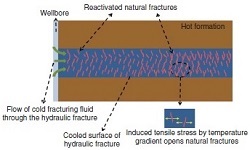 |
|
Hydraulic Fracturing Modeling In general, solutions for fluid-driven fractures are tremendously difficult to construct even for simple geometries. This difficulty is due to moving boundary conditions, non-linearity of the governing equation for fluid flow in fractures, the high gradient of displacement and pressure near the fracture tip, and non-locality of the solution. Non-linearity comes from the fact that fracture permeability is a cubic function of the fracture width. HF modeling efforts in this group are mainly focused around using extended finite element method to solve this problem. In this approach, discontinuities like fractures are allowed to propagate independently of the mesh configuration by permitting the discontinuity to cross the elements. For this purpose, finite element space will be enriched by additional functions which are inspired from the analytical or asymptotic solution of the problem. For instance, it makes it possible to embed discontinuities in the solution space. The enrichment is performed from node to node in a mesh by activating extra degrees of freedom when needed. XFEM intrinsic advantages make it an excellent candidate to tackle hydraulic fracturing problems, specifically in complex geometries such as fracture coalescence and fracture diversion. |
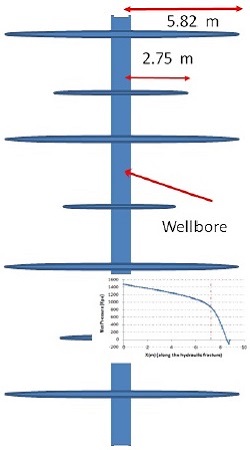 |
|
Hydraulic Fracturing Monitoring This research program, in cooperation with Dr. Juan Lorenzo in LSU geophysics, is focused on developing a novel concept for more accurate monitoring technology for safe hydraulic fracturing treatments in unconventional gas resources. This research effort includes a wide range of multidisciplinary efforts - from theoretical source mechanism calculations for hydraulic fractures to lab verification, field data interpretation and risk analysis of the proposed technology. |
 |
|
Underground Blowout
An underground blowout is an uncontrolled flow from the blowout zone to a weaker zone within the same wellbore. In most cases, the
influx fluid is contained in the subsurface formations receiving the flow, but in extreme cases, the flow will create a flow path to
the surface completely outside of the well itself. This scenario is then typically only containable by using a relief well at the
bottom of the blowout well to achieve a kill. In a typical kick control operation, the well is controlled by restricting the fluid
flow which causes the pressure in the well to increase. If the pressure in the well reaches a limiting value, failure of the formation
surrounding the well may occur, which can lead to underground blowout. |
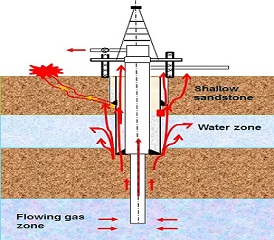 |
|
Zonal Fracture Propagation In Injectors The economics of water flooding projects mainly depend on large injection rates with longer injectors’ life. Frac Packs are being used increasingly in poor consolidated sands to control sands and maintain high injectivity at the injectors. Additionally, due to larger temperature differences, most deepwater injection wells will exhibit some degrees of thermal fracturing. This fracturing might be beneficial in decreasing fracture gradient and consequently improving injectivity in the short term. In the long term however, it causes a drop in injectivity. Because of undesirable and expensive well intervention later during production, a clear understanding of the physics in the vicinity of injectors is crucial to reduce water flooding costs as well as increase injection efficiency. |
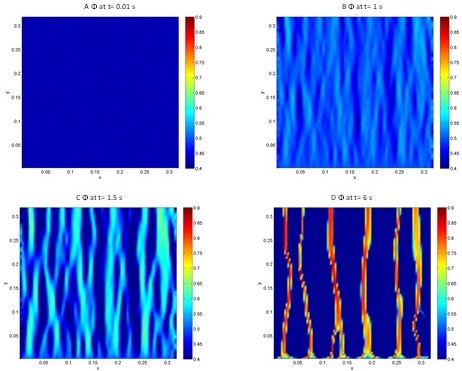 |
|
Drill Bit And Rock Interactions The interaction of the drill bit and rock (especially in soft rocks) includes complicated progressive contact and failure mechanisms that involve ductile to brittle fracture transitions in rock with simultaneous formation of ribbons due to high confining pressure. In this research, we utilize the results generate from the existing single Cutter apparatus to incorporate it into our mechanical damage models. We plan to use experiments to investigate the underlying fracture mechanisms of rocks to formulate a Continuum Damage Mechanics (CDM) based analysis framework, which considers several physical properties including rock anisotropic damaged properties, dynamic energy density, confining pressure and temperature effects. The proposed CDM schemeis alreadyvalidated against a wide range of experimental data. While the classical empirical and analytical methods used for this purpose are suffering from simplistic assumptions, this work proposes a robust predictive tool for studying the rock destruction behavior under drill bit contact action, and the developed scheme may also be deployed for the drill bit optimization by incorporating the effects of the formed ribbons and bit-balling. |
 |
|
Coupled Multiphysics Finite Element Method We developed coupled finite element code to couple stress and deformation with pore pressure, heat conduction and heat convection. Thermo-poroelasticity has a wide range of applications from heat extraction from geothermal reservoirs to design of hydraulic fracturing jobs in hydrocarbon reservoirs. Studying the thermoporoelastic behavior of rock enables us to consider the multiphysics nature of the heat exchange, may occur through conduction or convection, in conjunction with fluid flow close to the wellbore. Seismicity and land subsidence can be a critical issue in heat extraction from the geothermal reservoirs or waterflooding projects. The temperature drop may reduce the pore pressure through the porous medium around the production zone. Pore pressure reduction raises the effective stress and result in land subsidence. This mechanism is more important for the closed loop geothermal systems where there is no injection of working fluid thorough the geothermal reservoir. However, in the open loop systems, the reduction of pore pressure by exploiting of formation fluid from the underground can exacerbate the land subsidence. Elder’s problem is a benchmark problem for free heat convection where fluid flow is driven by density anomalies created by temperature differences. |
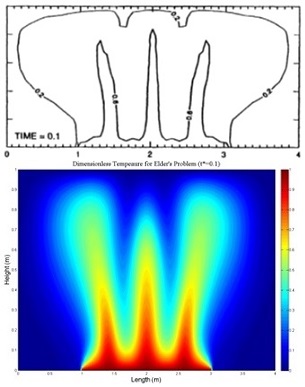 |